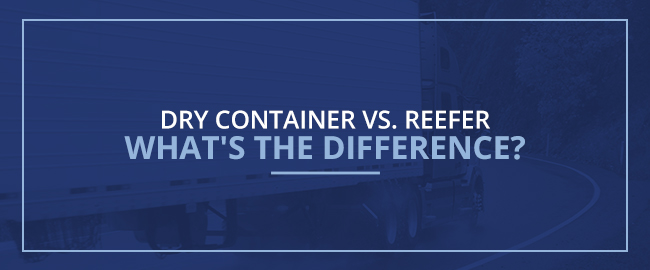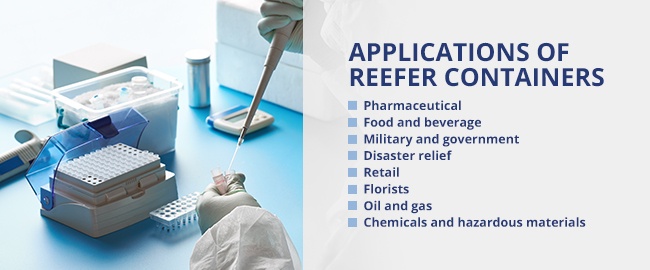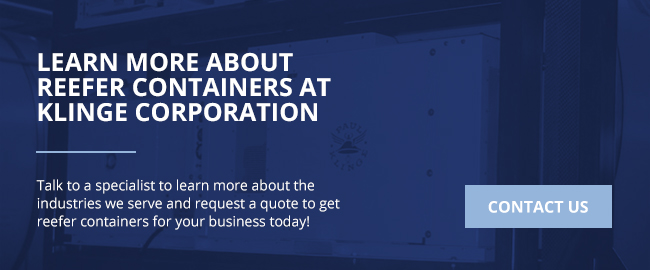
If your business relies on frequent bulk shipments, you have two primary options — dry and reefer container shipping. Read on to learn how they differ, including benefits and considerations, and how to determine which method is best for your product or business.
Table of Contents
- Reefer Container vs. Dry Container
- Dry Containers
- Reefer Containers
- Which Shipping Method Is Right for My Business or Product?
- Applications of Dry Containers
- Applications of Reefer Containers
- Learn More About Reefer Containers at Klinge Corporation
Reefer Container vs. Dry Container
Reefer and dry containers are similar because they both offer a fast, efficient shipping method for bulk amounts of items. You can also use both to transport items across land and sea, depending on the shipping company you partner with. Compared to air shipping, containers are more predictable, cost-efficient and capable of moving a higher number of heavier loads. The primary difference between normal containers and reefer containers is the design.
Dry Containers
Dry containers are a type of standard shipping or cargo container that accommodates dry, non-temperature-sensitive shipments. They are typically available in 40′ size, although there are 20′ options available. The containers consist of strong steel to resist wind, rain and saltwater. You can customize a dry container to have more security or added features for special loads in some cases.
Some dry containers commonly used across industries include:
- Storage roll containers
- Half-height containers
- Open-top containers
- Double door containers
- Open-side containers
- Tunnel containers
- Flat racks
Dry containers are versatile. In addition to bulk international shipping, many businesses have converted unused containers into innovative structures, like workstations, mobile clinics, retail stores, restaurants, food trucks, heavy equipment storage solutions, warehouses and even residential living.
Reefer Containers
Reefer containers are insulated, refrigerated shipping containers with a built-in climate control unit to manage internal conditions. Reefer containers let you control the temperature, humidity and airflow inside the shipment to keep temperature-sensitive perishable items safe during long distances. They are an integral component of the cold-chain shipping process. Reefer containers usually come with metal walls, ceilings and roofs due to the nature of the products inside. Paired with the refrigeration unit, this makes them heavier than dry containers.
Reefer containers are also typically available in either 40′ or 20′ configurations. Most standard reefer containers are not self-powered and require generator sets on the chassis when transporting to and from the port. Some more specialized reefer containers, such as those provided by Klinge Corporation, also incorporate an on-board power source, reducing the logistics requirements for sourcing generator sets for the inland moves.
Which Shipping Method Is Right for My Business or Product?
If you’re unsure which shipping method is right for your business or product, consider your industry and the goods you’re transporting.
Applications of Dry Containers
Dry containers are the standard shipping method for bulk items that are not liquid, gas, temperature-sensitive, perishable or hazardous if mishandled. These exceptions aside, these units can typically transport any material or manufactured goods, regardless of size, quantity and shape.
Some common shipment types for dry containers are:
- Books and paper products.
- Furniture.
- Vehicle parts.
- Coal and stone.
- Clothing.
- Toys.
- Sand.
- Grains, sugars and salts.
- Building materials.
- Tools and equipment.
Some items, like vehicles or large machinery, may not be ideal for this method of container shipping.

Applications of Reefer Containers
Reefer containers offer optimal protection for precious cargo, including perishable and environmentally sensitive goods. They help you remain compliant with local and industry regulations and safety standards. For items that demand more control — like self-reacting substances, flammables and pharmaceutical products — you can move your shipment with specialized reefers with dual refrigeration units and backup power supplies.
Reefers are the best way to ensure your products arrive safely and in the same condition that they left your facility — a level of quality assurance the end-user and your reputation both rely on. They also protect the employees and shipment handlers who help move your transport along the way.
The following industries depend on reefer containers to get their products to other businesses or consumers:
- Pharmaceutical: Pharmacies and pharmaceutical development companies rely on precise reefer refrigeration to ship medicine, vitamins and some medical tools and supplies to hospitals and clinics worldwide.
- Food and beverage: Grocery stores and food and beverage manufacturers use reefers to transport perishables, like meat, dairy, chocolate and produce. Reefers can reach ultra-low temperatures to maintain frozen items. Some restaurants also use reefers to receive fresher seafood, meat and produce for their menu.
- Military and government: Specially designed reefer containers are used in military and government applications, including testing sites and deployment areas. They have enhanced security features to meet stringent safety standards, like electromagnetic interference and vibration resistance. These solutions offer a safer mode of product transport and storage in challenging areas.
- Disaster relief: Reefer shipments are a great way to combat natural disasters and aid communities. They offer a fast, bulk shipment option for critical perishables, like medicine and food, that may otherwise be challenging to ship on short notice.
- Retail: Small retailers and big-box stores use reefers to ship various temperature-sensitive goods, like candles, cosmetics, fine jewels and skincare products.
- Florists: Large-scale floral and arborist shipments need a safe, controlled environment to sustain plants at all growth stages.
- Art and film: Fine art, including rare paintings and breakable pottery pieces, need ultra-controlled shipping conditions to maintain their quality and meet buyer or collector requirements. Film studios also use reefers to move sensitive handmade props.
- Oil and gas: Offshore oil and gas entities use reefer containers to move highly flammable and sensitive cargo and keep workers safe.
- Chemicals and hazardous materials: Climate-controlled shipping containers are often the most effective method for shipping flammable solids, desensitized explosives, organic peroxides, self-reactive substances and hazardous chemicals. These reefers have explosion-proof components and always use continuous refrigeration.
Many industries and businesses that do not currently rely on reefer shipping could benefit from this level of environmental control. Even standard, non-perishable dry items are at risk for extreme temperatures. In 2019, Arizona experienced such a drastic heat wave that even street signs and mailboxes began to melt. Temperatures like these are unpredictable and could cause severe profit loss for businesses that aren’t prepared with alternative container options.

Learn More About Reefer Containers at Klinge Corporation
Moving perishable and temperature-sensitive products requires carefully designed containers to keep your business, product, staff and end-user safe and satisfied. Klinge Corporation has the temperature-controlled shipping containers you need to store or transport your sensitive cargo. Talk to a specialist to learn more about the industries we serve and request a quote to get reefer containers for your business today!
